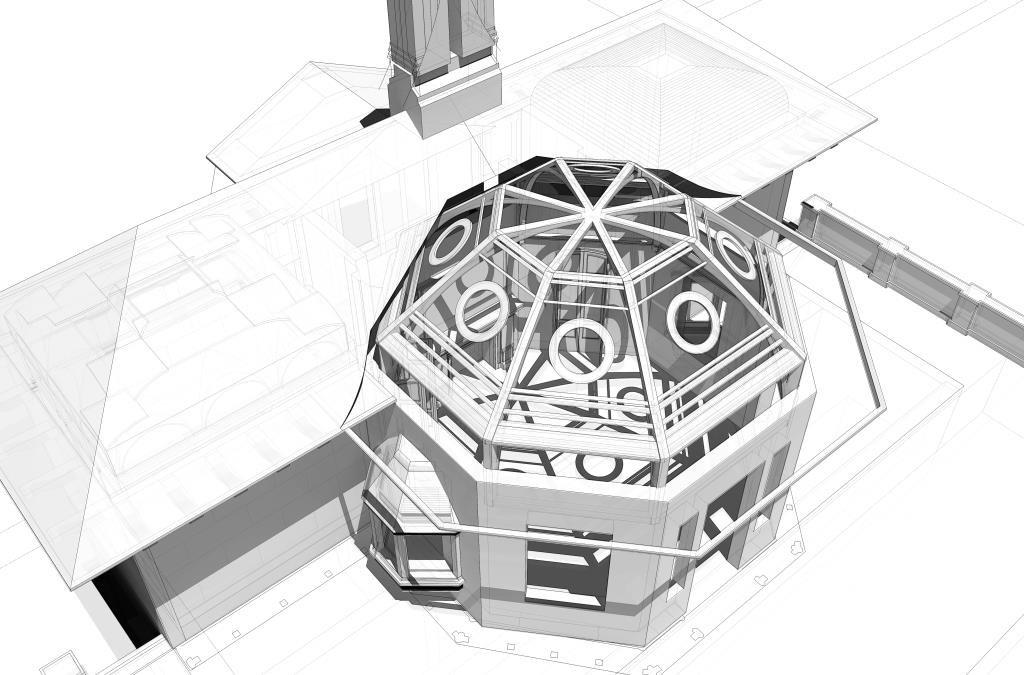We recently received the happy news that several of our staff will share a poster about the pavilion project at DHSI in Summer 2014. Not only will this represent the first public demonstration of our in-process model, it represents the first time our English department team members have presented a professional poster. We asked our colleagues in architecture, “Do you all ever make these?” The GRAs laughed, as they generate these routinely, sometimes weekly, for group critiques in the College of Design.
We’ve reached an interesting moment in the project when conversations are turning to what and how we collectively plan to share. As a group, we’ve agreed since the start on preliminary long-term plans for the project. The poster has pushed us to decide upon what, in the parlance of research offices, might be the project’s discrete “outcomes” along the way. Now seeing the horizon of the project’s seed funding, what sorts of incremental successes can we deliver? And given the competitiveness of larger implementation funding for such projects, how might we structure the project to succeed as a research platform even given the absence of such support in the future?
We have some plans and have adjusted our research and production schedule to hopefully share the initial models at DHSI. For me, this has valuably complicated my naive thinking about projects beyond the spectrum of proposal -> process -> product. Many conversations in humanities computing and DH have emphasized process as itself a viable outcome of the work. In other words, work in DH even if necessarily inconclusive delivers lessons about how we conceptualize, execute, and reflect on our scholarly suppositions. In a similar spirit, our architecture GRAs have advised us to approach a poster as a statement of process, rather than as a billboard for a completed exercise. At the same time, I’ve felt a weariness in the DH community and in its interlocutors about seeming stuck in process, about re-engineering shortcomings as a model for success or what has been called the importance of failure. As a digital media librarian objected at a recent THATCamp: You know what’s better than failure? Actually making something that works.
That can be a tall order given the scale and ambition of the digital humanities and interdisciplinary projects that scholars, students, and staff have been encouraged to imagine. It also sets up a false binary that breaks down during the experience of project management. Bethany Nowviskie calls this necessary realization “graceful degradation“: how we imagine and plan for the fruitful afterlives of projects given the shifting sands of funding and sustainability. What about envisioning this from the start of the project, as opposed to its end, in the same spirit? Projects can equally possess a “elegant scaffolding” to deliver useful structures throughout their life cycle.
In journalism, the “inverted pyramid” refers to the technique of front-loading essential content in a news story, starting with the lede. The farther the article goes, the more it can dilate to compass the details and implications of its central story. The motivation here isn’t just satisfying readers pressed for time: it’s to defend the integrity of your story from a ruthless editor who, pressed for space, might cut it anywhere. Along the same lines, what sorts of deliverable milestones can a project gracefully envision from its outset, as if it were periodically abbreviated? Beyond process-based lessons about, say, a half-built virtual model of a historical building, what can we generate along the timeline of our gradually increasing investments of time and research?
For the pavilion project, our GRAs are generating virtual scaffolding of escalating detail and grace. It’s our job, as a team, to envision and deliver gradual implementations of our collaborative work, inclusive of lessons about process as well as stuff that, in a variety of scales and contexts, actually works. Stay tuned.

